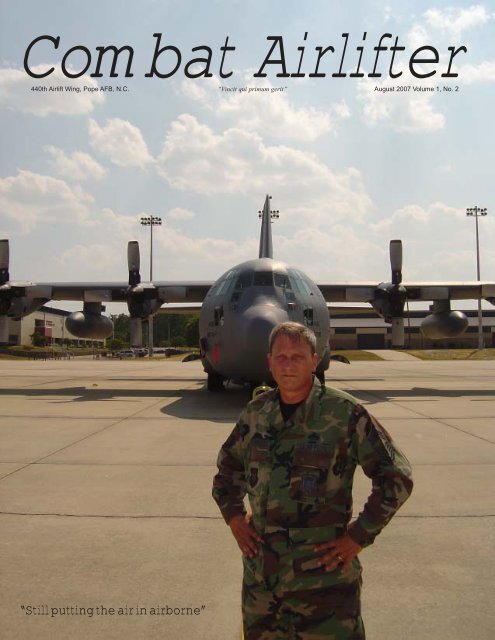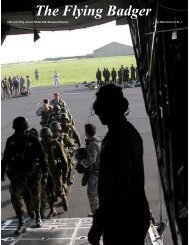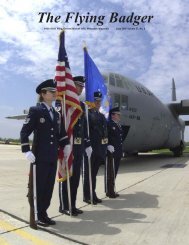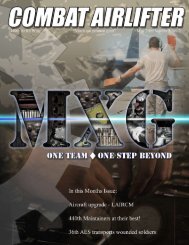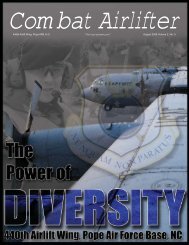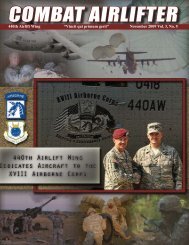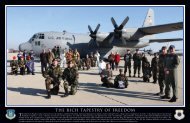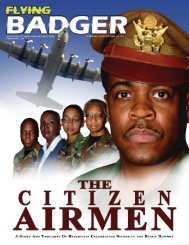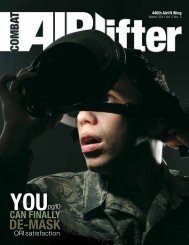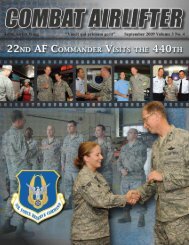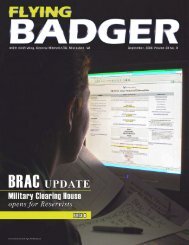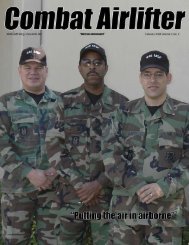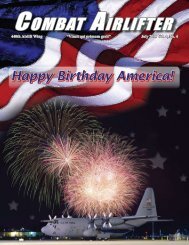CA August 2007 for CD.pmd - 440th Airlift Wing
CA August 2007 for CD.pmd - 440th Airlift Wing
CA August 2007 for CD.pmd - 440th Airlift Wing
- No tags were found...
You also want an ePaper? Increase the reach of your titles
YUMPU automatically turns print PDFs into web optimized ePapers that Google loves.
Combat <strong>Airlift</strong>er<strong>440th</strong> <strong>Airlift</strong> <strong>Wing</strong>, Pope AFB, N.C. “Vincit qui primum gerit” <strong>August</strong> <strong>2007</strong> Volume 1, No. 2“Still putting the air in airborne”
TheCombat <strong>Airlift</strong>erVolume 1, No. 2<strong>August</strong> <strong>2007</strong><strong>Wing</strong> CommanderCol. Merle D. HartDirector, Public AffairsDennis J. Mehring<strong>Wing</strong> Chief, Public AffairsLt. Col. Ann Peru KnabePublic Affairs Staff1st Lt. Jeff SchoenTech. Sgt. Steve StaedlerSenior Airman Amanda HillLiz A. StoeckmannOffice of Public Affairs<strong>440th</strong> <strong>Airlift</strong> <strong>Wing</strong>374 Maynard St. Suite 301Pope AFB, NC 28308-2409Phone: 910.394.5455FAX: 910.394.5459http://440aw.afrc.af.milThis funded Air Force newspaperis an authorized publication<strong>for</strong> members of the U.S. militaryand their families. Contents ofthe Combat <strong>Airlift</strong>er are notnecessarily the official view of,or endorsed by, the U.S.government, Department ofDefense or Department of theAir Force. Content is compiled,originated and developed by thePublic Affairs staff of the <strong>440th</strong><strong>Airlift</strong> <strong>Wing</strong>, Air Force ReserveCommand. All photos are AirForce photos unless otherwiseindicated in the photo byline.On the cover:Chief Danny Formanski, <strong>440th</strong>Maintenance Squadron, isconsidered a “hybrid,” one ofthe first <strong>440th</strong> reservists tomove to Pope Air Force Base,N.C. Read more about thehybrids on page 3.photo by Staff Sgt. Joe Starkby Col. Harry Heflin<strong>440th</strong> <strong>Airlift</strong> <strong>Wing</strong> Inspector GeneralThis column is usually reserved <strong>for</strong> a topic that ismeant to inspire, motivate or reflect upon something— a person, place or thing — that is relevant at thetime. With that thought in mind, I want to use thisvenue to offer my thoughts on what makes the womenand men of the 440 th <strong>Airlift</strong> <strong>Wing</strong> so special. I havechosen to do this with a golf analogy.In its purest <strong>for</strong>m, golf is a very simple game; justget the ball in the hole, <strong>for</strong> eighteen holes. It’s thejourney — the obstacles encountered throughout theround — that makes it so difficult.So what is it that sets the top golfers in the worldapart from the rest of the pack?They have the ability to focus on turning endlesshours of sacrifice, training and passion into setting upwinning opportunities. They understand the importanceof making every shot count, but more importantly,focusing on the next shot — not the last shot.They have a vision. They trust their swing and theydon’t focus on the obstacles.What then, sets the women and men of the 440 th<strong>Airlift</strong> <strong>Wing</strong> apart fromall the rest of the unitsthroughout Air ForceReserve Command —and in my opinion therest of the UnitedStates Air Force?For me, it’s notmuch different from theprofessional golfer;each member of the 440 th has repeatedly demonstratedthe ability to focus on the job at hand, come together asa team and get the job done safely — in spite of theobstacles encountered along the journey. Right now,wing members remain mission ready, and even in theCommand PerspectiveThe legacy lives on,make every shot count“Maintain your passion to excel andcontinue to serve proudly, focus onthe next shot, trust your swing anddon’t focus on the obstacles.”Col. Harry Heflin, <strong>440th</strong> <strong>Airlift</strong> <strong>Wing</strong> inspector generalmidst of a BRAC move, the 440 th is fully combat capable.Whether you arealready a part of the440 th <strong>Airlift</strong> <strong>Wing</strong> atPope AFB, joining anotherAir Force unit oranother branch of service,or if you have orwill be retiring; rememberto make every shotcount.Maintain your passion to excel and continue to serveproudly, focus on the next shot, trust your swing anddon’t focus on the obstacles. Do these things and youcan rest assured the legacy of the 440 th will live on. Allthe best and God’s speed!Page 2 The Combat <strong>Airlift</strong>er <strong>August</strong> <strong>2007</strong>
FeatureThe history of the HybridsDedicated Airmen key to success of Det. 1 at Popeby Dennis MehringThe recommendations of theBase Realignment and Closure Commissionbecame law in November of2005 and once it did the future ofGeneral Mitchell Air Reserve Station,Wis., was settled. The wingwas going to be moved to Pope AirForce Base, N.C., so two of the firstquestions that had to be answeredby the members of the 440 th whowere staying with the wing were“How do we get this outfit moved?”and “Who is going to move first?”The first people to move to PopeAFB arrived on <strong>August</strong> 20, 2006.They were: Col. Brett Clark, Det. 1commander, Col. Mark Rodriguez(an individual mobilizationaugmentee from Oklahoma City,Okla.) Maj. Derek Poellet, ChiefMaster Sgt. Danny Formanski, SeniorMaster Sergeants Bill Westlingand Lynn Klapste, Master SergeantsTerry Harper and Jennifer Drewitz,and Tech. Sergeants Dave Websterand Mark Ulmen.The original members of Det. 1called themselves “The Hybrids.”The best definition of a hybrid isprobably “something that has twodifferent types of components per<strong>for</strong>mingessentially the same function.”Having their roots and thevast majority of the wing in Wisconsin,their jobs in North Carolinawould undoubtedly contribute tosuch a belief. The commander of thedetachment was Colonel Clark, thecurrent 440 th Operations Groupcommander. Colonel Clark had beenthe commander of the 94 th OperationsGroup at Dobbins Air ForceBase, Ga., when he was given hiscurrent assignment. He said that hehad two big challenges.“I was going to ask them (theother members of Det. 1) to sprintand not jog through this assignment.The normal pace of operations thatthey were used to was not going tobe enough. They also had to be jacksof all trades. If someone was a specialistin maintenance, that personhad to be ready to drop what theywere doing and help get work donein some other unrelated area.” ColonelClark was as good as his word.One Hybrid provided a partiallist of job responsibilities taken onfrom 2006 to <strong>2007</strong>: civilian timekeeper,orders clerk, services, governmentpurchase card management,contracting, computer support, individualequipment custodian, andvehicle management. None of theseduties are part of that specialist’snormal career field.Major Poellet was a captain whenhe moved himself and his family toPope in 2006. How did he end upas a member of Det. 1?“I was requested by ColonelFlournoy (22nd Air Force actingChief of Staff) and I thought Ishouldn’t turn down this opportunity,”Major Poellet said.He was asked what he thoughtwas the biggest challenge to beingone of the first 440 th Reservists atPope. It did not take long <strong>for</strong> him tonarrow down the challenge to “Identifyingall the responsibilities thatwould be necessary to become selfsustaining. There are so many thingsa wing has to do and we still havenot finished that job. For example,we had to establish financial accounts,supply accounts, figure outadditional duties like unit securityand flight line driving managers. TheNSPS system (new personnel ratingsystem <strong>for</strong> Federal employees)has been quite a challenge.”The easiest question he was“It’s been an experience I’ll keepwith me <strong>for</strong> the rest of my career.”- Maj. Derek Poelletasked was, “Are you feeling morecom<strong>for</strong>table and confident now thatmore people have been hired andthere are more familiar faces aroundyou? His reply was a firmly spoken,“YES! It’s been an experienceI’ll keep with me <strong>for</strong> the rest of mycareer. I’ve learned so much aboutwhat it takes to operate a wing.”Master Sgt. Jennifer Drewitz hadthis to say about her experience as aHybrid. “The job to date has beenextreme. The processes that we took<strong>for</strong> granted back in Milwaukee werenot in place <strong>for</strong> us here. The simplesttask was a chore because everythinghad to be done from scratch.It took weeks <strong>for</strong> us to get our localline badges. We (the original Hybrids)all had to step up and take onduties outside our normal specialties.I work in Maintenance and rightnow I’m processing line badges <strong>for</strong>the wing.”Even though her Reserve dutieshave been a challenge, Master Sgt.Drewitz said that her biggest challengewas “finding a good school <strong>for</strong>my son and finding a good place tolive.” She wanted the change to beas seamless as possible.Starting a new project is alwaysdaunting, but try to imagine the complexitiesinvolved in creating a baseof operations <strong>for</strong> hundreds of interdependentpeople in a new locationa thousand miles away from all thesupports you know and are com<strong>for</strong>tablewith. As of this date hundredsof people have been hired andmore than a hundred ART positionsstill need to filled, but the flag hasbeen transferred, planes are beingmoved to North Carolina and thewing is still working and flying. Det.1’s operations have come to an end,but the record of what they wereable to accomplish in such a shorttime will be evident to all 440 th members<strong>for</strong> months andyears to come.The Combat <strong>Airlift</strong>er <strong>August</strong> <strong>2007</strong> Page 3
Dentist named new <strong>440th</strong>MDS commanderBy Lt. Col. Ann Peru KnabeWith nearly 20 years experience serving thewing, Col. (Dr.) Richard “Bruce” Fischer assumedcommand of the 440 th Medical Squadron lastmonth. As he spoke to a room full of reservistsduring his assumption of command ceremony,the new MDS commander commented on thegrowth and maturity of the squadron during thelast two decades.“When I first joined the unit as a first lieutenant,we accomplished our mission, but it seemeda little disorganized,” he said. “But our Airmenhad outstanding qualities. Today we have the sameoutstanding core qualities, but have turned theunit machine into the excellence recognized byAir Force Reserve Command.”Dr. Fischer thinks the high caliber of thepeople will make his job easier.“The challenge will be to lead them throughour transition to Pope and a large influx of newNewsmembers,” said the dentist from Tomah, Wis.Previously serving as the 440 th ’s chief of dentalservices, Dr. Fischer graduated from MarquetteUniversity Dental School in Milwaukee. He joinedthe military in 1988, earning a direct commission,and was called to active duty <strong>for</strong> Operation DesertStorm.A chief master dentist with more than 23 yearsof clinical experience, he has commanded numeroustours of duty. He has also served on medicaland dental task <strong>for</strong>ces <strong>for</strong> 22 nd Air Force, and is amember of the Air Force Reserve Dental AdvisoryBoard.“Colonel Fisher has a wealth of professionalexperience and history with the wing,” said Col.Merle D. Hart, 440 th <strong>Airlift</strong> <strong>Wing</strong> commander. “Iam confident his new leadership role at Pope willshine like all of his other accomplishments.”Dr. Fischer said he refers to a print on his wallwhen thinking about his new role as a commander.“To paraphrase, it says leadership is not tak-Col. Richard “Bruce” Fischer, <strong>440th</strong> MedicalSquadron Commandering people where they want to go, it’s takingthem to where they ought to be,” he said.“I plan to use this philosophy in leading themedical squadron. With the support of the wingleadership through guidance and mentoring, I seea continued tradition of success.”Knack <strong>for</strong> numbers earns 440 th reservist 22nd AF’sGen. Wagner Administrative Excellence nominationBy Lt. Col. Ann Peru KnabeMaj. Shanon Madrid’s eagle eye <strong>for</strong> numbersand accuracy jumps-out at senior leaders inthe wing and 22nd Air Force. Newly assigned tothe 440 th Medical Squadron, the medical servicecorps officer earned 22nd Air Force’s nomination<strong>for</strong> the Brig. General Donald B. Wagner AdministrativeExcellence Award while serving as an IndividualMobilization Augmentee last year.“She’s engaged each assignment with energyand enthusiasm,” said Lt. Col. Lynanne St.Laurent, Major Madrid’s <strong>for</strong>mer commander. “Shesharpened data integrity, resolved process problemsand provided spectacular support in managementof more than 250 manpower positions.”The reservist was nominated <strong>for</strong> the GeneralWagner award based on her “superior allocationof resources” and attention to detail in numerousmilitary programs involving accountingand related documentation. She optimized thecivilian pay program in her <strong>for</strong>mer unit, and identifiederrors in accounting, saving an additional$75,000 <strong>for</strong> medical programs. Major Madrid wasalso cited <strong>for</strong> her work preparing <strong>for</strong> the unit’shealth services inspection.“She’s one of the best,” said an HIS evaluatorduring the inspection, referring to thereservist’s work in establishing a line of duty programwith clear processes and creation of a patientchecklist and how-to guide that streamlinedthe referral management process. The major’swork resulted in a 15 percent improvement duringthe first month. Major Madrid was also cited<strong>for</strong> her extensive work in the community. As theco-chair <strong>for</strong> the Garner Relay <strong>for</strong> Life walk, shehelped raise more than $650,000 <strong>for</strong> cancer researchin North Carolina’s largest fundraisingevent. The 440 th reservist also volunteers as acommander <strong>for</strong> the Apex, N.C., Civil Air Patrol.She teaches young <strong>CA</strong>P cadets the history of themilitary and discipline, and coordinates flying withthe Young Eagles program.“Shanon is clearly an asset to the 440 th MedicalSquadron,” said Col. Richard “Bruce” Fischer,440 th MDS commander. “Her talent with numbers,management and people will be an excellentaddition to our team.”Page 4 The Combat <strong>Airlift</strong>er <strong>August</strong> <strong>2007</strong>
News440 th nurse named22nd AF’s OutstandingMedical Reserve Officerby Lt. Col. Ann Peru KnabeThe sound of a helicopter landing signaled another criticalpatient arriving at the Air Force Theater Hospital at BaladAir Base, Iraq. It could have been a Soldier missing limb, aMarine badly burned or an Airman with fractured bones. Itdidn’t matter; Lt. Col. Therese Kern was ready to triage theinjured, per<strong>for</strong>m CPR or simply hold a scaredservicemember’s hand during the night. Thousands of milesfrom home, the 440 th <strong>Airlift</strong> <strong>Wing</strong> Reservist from Wind Lake,Wis., was doing what she loved most, bedside care.“I love the hands-on patientcare,” she said, referring to her airexpeditionary tour in Iraq. “It’s hardto describe the feeling I get when Iam helping these soldiers that comein off the battlefield. It’s a feeling Iwill never <strong>for</strong>get.”Based on her work in the wartheater and skilled management backat her home unit, Colonel Kern wasnamed 22 nd Air Force’s OutstandingReserve Officer Assigned to aDeployable Medical Unit.When she is not deployed, ColonelKern serves as the 440 th MedicalSquadron chief of nursing.The medical statistics underColonel Kern speak <strong>for</strong> themselves.During the last year, on a typicalUTA, she expedited medical care <strong>for</strong>more than 700 walk-ins a month.Under her direction, the unit gavemore 5674 immunizations, per<strong>for</strong>med907 dental exams and drew4616 blood samplings.“The patient satisfaction ratespeaks volumes,” said Col. Richard“Bruce” Fischer, 440 th MedicalSquadron commander. “Airmenrated medical squadron per<strong>for</strong>manceLt. Col. Therese Kern cares <strong>for</strong> a young boy while deployed last year toBalad Air Base, Iraq. Her ef<strong>for</strong>ts earned her recognition as 22nd AirForce’s Outstanding Reserve Officer Assigned to a Deployable MedicalUnit.at a 98 percent satisfaction rate.We’re lucky to have a dedicated professionallike Lt. Colonel Kern tohelp us reach this level of excellence.”Other senior officers have notedColonel Kern’s leadership ability.She was hand-picked to supervisethe night shift at the busiesthospital in Iraq, where she deliveredcare to more than 1200 U.S.servicemembers, Iraqi soldiers, prisonersof war and civilians. She waspraised by her coworkers and Iraqiinterpreters <strong>for</strong> her compassion andempathy while caring <strong>for</strong> others.Colonel Kern will continue herservice as chief of nursing with the440 th Medical Squadron at Pope AirForce Base, N.C.<strong>440th</strong> MDS named 22nd AF’s Outstanding Medical Squadron and DetachmentThe <strong>440th</strong> Medical Squadron has beennamed 22nd Air Force’s Outstanding MedicalSquadron and Detachment with ExpeditionaryMedical Support.The MDS continued an agressive deploymentschedule, even after the Base Realignmentand Closure commission recommended closingGeneral Mitchell Air Reserve Station. The unitsupported multiple Air Expeditionary Flight Rotationsto Puerto Rico, Alaska, Chad, Iraq andGermany. Deployed members played critical rolesin helping thousands of injured servicemembersand coalition partners. One reservist saved thelives of two children while under sniper fire, andsuccessfully defended patients during attacks.The MDS was also lauded as one of threeAir Force Reserve units to achieve DOD’s IndividualMedical Readiness goal requiring more than76 percent medical suitability of members <strong>for</strong>world-wide duty.The squadron also demobolized membersof the 95th <strong>Airlift</strong> Squadron, <strong>440th</strong> MaintenanceSquadron and 45th <strong>Airlift</strong> <strong>Wing</strong> with 100 percentsatisfaction rate.The Combat <strong>Airlift</strong>er <strong>August</strong> <strong>2007</strong> Page 5
FeatureAir Force Reservist Capt. Grady “G-Man” Dieckert, 95 th <strong>Airlift</strong> Squadron pilot, briefs Maj. Joni Clemens and Capt. Kathy Martin prior to flying anaeromedical training mission on July 19. Major Clemens served as the 43 rd Aeromedical Evacuation Squadron medical crew director on one of theflights. Captain Martin is the 43 rd AES element chief <strong>for</strong> aircrew training. The July 19 flight was one of the first operational missions <strong>for</strong> the 440 th <strong>Airlift</strong><strong>Wing</strong> to fly from its new location at Pope Air Force Base, N.C. The Reserve unit moved to North Carolina from Wisconsin in June.ThinkingSmart 95th <strong>Airlift</strong> Squadron partnerswith active duty aeromedicalsquadron <strong>for</strong> ‘win-win’ trainingStories and photos byLt. Col. Ann Peru KnabeAs the “patient” struggled to breathe, themedical technicians and flight nurses from the43 rd Aeromedical Evacuation Squadron gave theirbest ef<strong>for</strong>ts to save his life. He had suffered bilateralburns on the eyes, and was being flown on aC-130. But his condition worsened. Soon he wasstruggling to breathe, and the aeromedical teamstarted suctioning his mouth. Then his pulsePage 6 The Combat <strong>Airlift</strong>er <strong>August</strong> <strong>2007</strong>oximeter reading fell from 87 percent to 70 percent,and the aeromeds intubated him since hecould no longer breathe on his own. The excitingpart of this story is not that “the patient” survived(it was a simulated exercise, after all), butthe fact that it was a <strong>440th</strong> <strong>Airlift</strong> <strong>Wing</strong> Reserveaircrew flying active duty aeromeds.“The training partnership is a perfect match,”said Lt.Col. Stephen Chafe, 440 th <strong>Airlift</strong> <strong>Wing</strong>Det. 2 operations officer, calling it a “win-win”situation. “The active duty aeromedical unit fromPope needs training flights that last a couplehours in the air, and the 95 th <strong>Airlift</strong> Squadronneeds to keep its traditional reserve aircrew membersqualified.”Colonel Chafe explained the 95 th <strong>Airlift</strong>Squadron, now based at Pope Air Force Base,N.C., still has more than 50 traditional reservistswho live in Wisconsin and need to maintaincurrency. Back at Pope AFB, the 43 rd AES needed
FeatureAir Force Reservist Master Sgt. Randall Labodda, a loadmaster with the 95 th <strong>Airlift</strong> Squadron, confers with Maj. Joni Clemens, 43 rd AeromedicalEvacuation Squadron medical crew director, during a training flight on July 19. The flight was one of the first operational missions <strong>for</strong> the 440 th <strong>Airlift</strong><strong>Wing</strong> to fly from its new location at Pope Air Force Base, N.C.to train their aeromeds on real-world flights.“We were in a meeting at Pope last May, anda couple of us were talking with the aeromeds,when suddenly the light went on – why couldn’twe provide flights <strong>for</strong> aeromed training to Milwaukee?“The flight to Milwaukee is a little over twohours, and we the 95 th and 43 rd (AES) would bothbenefit. The real nut to crack was how to connectthe two missions.”It didn’t take long to figure it out. The firstaeromedical training from Pope to Milwaukee,and back to Pope, took place July 19. Both unitsfelt this opportunity was an excellent use of resources.“It was an example of wonderful integrationbetween the ‘front-end’ and AES,” saidCapt. Kathy Martin, referring to the collaborationbetween the 95 th aircrew and 43 rd aeromeds.“The 95 th did everything they could do to help ushave an exceptional training experience.”As the 43 rd AES element chief <strong>for</strong> aircrew training,Captain Martin looks <strong>for</strong>ward to continuingthe weekly training flights with the 440 th .“We had ample opportunity to practice allour scenarios,” she explained. During the twoflights the aeromeds simulated treating patientswith chemical burns, crush injuries, fracturedbones and breathing obstructions.The 95 th aircrew supported the exercise directlyresponding to simulate emergencies. Warninglights lit up during the flight telling the crewabout simulated rapid decompression and a fire.“The beauty of this training stateside is thatit reflects what is really going on in the war theater,”said Tech. Sgt. Stephanie Durham, whoserved as the mission clinical coordinator.“The majority of time I’ve flown in the AOR,it’s been with Reserve and Guard crews. So itmakes perfect sense – we need to train how wefight,” said Sergeant Durham.Maj. Derek Poellet, 95 th AS aircraft commander<strong>for</strong> the July 19 training mission, agreed.“It’s all about the active duty and Reserveworking together,” he said. “Our new organizationalstructure shows active duty units underour operations group. So it’s exciting to see usworking together so quickly.”In the next year, the 440 th Operations Groupwill gain a new Reserve squadron when the 440 thAeromedical Squadron is activated. In addition,the 440 th Operations Group will gain operationaldirection over the 43 rd AES (and 2 nd <strong>Airlift</strong> Squadron)when the much anticipated active associationis implemented.The Combat <strong>Airlift</strong>er <strong>August</strong> <strong>2007</strong> Page 7
News<strong>440th</strong> <strong>Airlift</strong> <strong>Wing</strong> comptrolleroffice open <strong>for</strong> business at PopeWASHINGTON (AFPN) — After examininghow much time Airmen spend on annual ancillarytraining, Air Force leaders have decidedthat time should be allocated more efficiently.In effect as of Oct. 1, ancillary training requirementswill be reduced to 90 minutes, as opposedto almost nine hours per Airman spreadthroughout the year.“An Airman’s time is valuable, one of themost precious commodities we have,” said AirForce Chief of Staff Gen. T. Michael Moseley. “Iwant a lot of our ancillary training to be combinedso Airmen can spend more time concentratingon their jobs.”The goal is to cut the time spent on ancillarytraining to the “minimum level necessary,” GeneralMoseley says in his latest “Chief’s Scope.”The initiative is part of Air Force SmartOperations <strong>for</strong> the 21st Century, an Air ForcebyMaj. Rick Jellison<strong>440th</strong> <strong>Airlift</strong> <strong>Wing</strong> ComptrollerA new comptroller organization has arrivedat Pope Air Force Base, N.C. The office move isa result of the base realignment and closure actionsthat were passed in late 2005. The 440 thFinancial Management Office is part of the 440 th<strong>Airlift</strong> <strong>Wing</strong>, the unit that moved its flag to PopeAFB on June 10.The 440 th FM offices are co-located withthe 43 rd Comptroller Squadron in building 315 onPope AFB. The FM management team is in theprocess of hiring the full-time and Reserve staffthat will manage all financial management operations<strong>for</strong> the 440 th AW. Those operations includebudgeting, transaction management, military andcivilian pay, and travel.Co-locating with the 43 rd CPTS will allowboth Comptroller organizations to gain synergythrough team work aimed at supporting all “TeamPope” members.As the military comptroller and chief financialofficer of the wing, I have two primary responsibilities.First, and <strong>for</strong>emost, I have theresponsibility to maintain a “ready to deploy”staff of combat comptrollers who are capable ofmeeting the requirements expected of a combatready wing.This is the primary function of my traditionalreservist staff and their training focus duringreserve training weekends.My other, and equally important function,is maintaining the day-to-day financial operationsof the 440 th , servicing about 250 full-time civilianMaj. Rick Jellison, <strong>440th</strong> Comptrollerand Air Reserve Technicians. My staff also managesthe Operations and Maintenance, and ReservePersonnel Appropriations that sustain thewing on a daily basis.Annual training requirements to be shortened to 90 minutesby Staff Sgt. J.G. BuzanowskiSecretary of the Air Force Public Affairswide program where organizations reexamine theirown procedures and processes to find ways tosave time and money.Under the new 90-minute “block instruction”plan, Airmen will save almost an entireworkday, or about 8.65 hours per person, accordingto Lt. Gen. Roger Brady, deputy chief ofstaff of Air Force manpower, personnel and services.General Brady’s team examined 16 differenttraining courses and redesigned how Airmenwill receive that in<strong>for</strong>mation. In an hour and ahalf, Airmen will receive blocks of training organizedinto categories that will simplify the trainingprocess without greatly diminishing the valueof the training itself.“I will not let ancillary training overshadowour combat focus,” General Moseley said. “Theseconcrete steps will tip the scales to give Airmenmore time to focus on their primary mission.”For even greater convenience, units will haveseveral options <strong>for</strong> completing all three blocks.Commanders will have the choice of holding theentire 90 minutes at once in a mass briefing, orsplit up into three segments throughout the year.The blocks also will be available as both groupand individual computer presentations.While the 90 minutes of instruction will meetannual requirements <strong>for</strong> Total Force Airmen, therewill continue to be additional, specific training<strong>for</strong> select Airmen. For example, new Airmen willstill need to attend initial security orientation attheir first duty station and Airmen changing dutystations to go overseas will require counterintelligencetraining. Although courses like these willstill be in addition to the annual required 90-minute training, there is a plan now that also willreduce the time it takes <strong>for</strong> these extra courses byup to 72 percent, General Brady said.“Our approach is aggressive and will <strong>for</strong>ceeveryone to justify how the benefits of their proposedtraining outweigh the burden on our Airmen,”General Brady said.Page 8 The Combat <strong>Airlift</strong>er <strong>August</strong> <strong>2007</strong>
NewsNew rules require technicians towear military uni<strong>for</strong>ms fulltimeROBINS AIR FORCE BASE, Ga. – Whenpeople visit an Air Force Reserve Command unitduring the week in the coming months, they arelikely to see more people in military uni<strong>for</strong>ms.The Air Force changed three of its instructionsAug. 7 to require all air reserve techniciansto wear military uni<strong>for</strong>ms rather than civilianclothes while working in civilian status. ARTs arefull-time civilian employees who serve in the samejob as Air Force reservists. They’ve been wearinguni<strong>for</strong>ms when in military status.ARTs in some locations are already wearingtheir uni<strong>for</strong>ms all of the time at work. Othershaven’t started wearing their uni<strong>for</strong>ms everydaybecause they have not been required to do so.“We want our ARTs to be in uni<strong>for</strong>m becausewe are integrating with the Regular Air Forceand Air National Guard throughout the Air Force,”said Lt. Gen. John A. Bradley, AFRC commander.“Total Force Integration is changing how we interactwith the rest of the Air Force.“Even be<strong>for</strong>e 9/11, the regular componentdepended on us to get the job done,” he said.“That dependency is growing because we cannotaf<strong>for</strong>d to do business as usual. We need to consolidateour <strong>for</strong>ces and capitalize on each other’sstrengths.”As example of progress, General Bradleycited reservists preparing to fly F-22s with theRegular Air Force in Alaska, reservists flying theirown C-17s in Cali<strong>for</strong>nia and reservists standingup and managing a C-130 unit in North Carolinawith an active associate unit.“We are able to take on new and challengingmissions because of the skills and experience ofour air reserve technicians,” said Chief MasterSgt. Troy McIntosh, AFRC command chief mastersergeant. “Some technicians have told me theyfeel this uni<strong>for</strong>m change is calling their militarydedication or patriotism into question,” said thechief. “That is not at all the case. Our technicianshave proved themselves in the past and, I’m confident,they will continue to do so in the future.”The Air Force Reserve has about 1,335 ARTofficers and 8,400 ART enlisted people. (Air ForceReserve Command News Service)Stay connected<strong>440th</strong> Alumni AssociationThe 440 th Alumni Association encourages<strong>440th</strong> members and friendsto join. In addition to in<strong>for</strong>mation sharing,regular meetings give people theopportunity to stay in touch with fellow<strong>440th</strong> members and stay currentwith the people and history of the440 th .For more in<strong>for</strong>mation, call Ed Thomasat 482-5303 or Larry Guentherat 482-5401 on base. More in<strong>for</strong>mationis also available from Al Shuttaat 414-282-9225 or James Andersonat 262-821-1841, or Ed Thomas at414-427-8256 or Larry Guenther at262-284-9779.The Association meets the secondThursday of the month at Amelia’s<strong>for</strong> lunch and camaraderie. Amelia’srestaurant is located at 724 E. LaytonAve.TRI<strong>CA</strong>RE Select Reserve insurance available to all reservists Oct. 1ROBINS AIR FORCE BASE,Ga. (AFPN) — Reservists can beginsigning up Aug. 11 <strong>for</strong> more af<strong>for</strong>dableTricare Select Reservehealth care that starts Oct. 1.For some, it means they will paya third of what they are paying today.“All drilling reservists, includingindividual mobilization augmentees,will have access to the health-carebenefit at its lowest premium rate,”said Lt. Col. Alexander Alex, AirForce Reserve Command’s healthbenefits manager.“Interested reservists, includingthose who are currently enrolled inTricare Reserve Select, must fill outa newly developed Defense DepartmentForm 2896-1 to take part inthis restructured program.”In the <strong>2007</strong> National DefenseAuthorization Act, Congress toldDefense Department officials to restructurethe plan’s three-tier paymentsystem, which has been in effectsince 2006. Dr. David S.C. Chu,deputy secretary of defense <strong>for</strong> personneland readiness, signed the newpolicy Aug. 3.Under the system that endsSept. 30, only reservists on or recentlyreturned from a contingencyoperation qualify <strong>for</strong> Tier 1, the lowestcost premium.Reservists in Tier 3 pay the mosteach month, $247 <strong>for</strong> the reservistalone and $767.41 <strong>for</strong> the reservistand family. They include peoplewho haven’t been in a contingencyrecently, who are not self-employed,who work <strong>for</strong> an employer who offersa health care plan or who do notqualify <strong>for</strong> unemployment compensationas determined by state law.That all changes starting Oct. 1.All drilling reservists will pay thelowest premium, $81 a month <strong>for</strong>single coverage. Monthly premiums<strong>for</strong> reservists and families will be$253. Tricare will adjust premiumsannually on Jan. 1.“We’ve been working hard <strong>for</strong>years to improve health-care benefits<strong>for</strong> all reservists, and this is abig step in that process,” said Maj.Gen. Allan R. Poulin, AFRC’s vicecommander.The general encourages all reserviststo study the program to see if itmeets their needs.“As a health-care consultant, Ihave looked at numerous plans,”Colonel Alex said. “And this is avery competitive 80/20 indemnityplan where the government pays 80percent and the member pays 20 percentof the cost share.“One of its huge benefits is thepharmacy program,” he said. “Ifused wisely, members can get a 90-day supply of medicine <strong>for</strong> $3 perprescription.”Another plus to the plan is its$1,000 catastrophic cap, among thelowest in the industry, according toColonel Alex.“Once a member has paid $1,000in a fiscal year, Tricare will pay 100percent of the Tricare allowable costafter that,” he said.The Combat <strong>Airlift</strong>er <strong>August</strong> <strong>2007</strong> Page 9
Final NotesLt. Col. Michael Day, a navigator with the 95th <strong>Airlift</strong> Squadron, updates the flight plan on the self-contained navigation systerm during a <strong>440th</strong> <strong>Airlift</strong><strong>Wing</strong> mission. Like all the <strong>440th</strong> units, the 95th AS is looking <strong>for</strong> sharp, motivated people who want to serve on a winning team.photo by Lt. Col. Ann Peru KnabeLodgingIn<strong>for</strong>mation<strong>440th</strong> <strong>Airlift</strong> <strong>Wing</strong>374 Maynard St. Suite 301Pope AFB, NC 28308-2409PRESORTEDFIRST-CLASS MAILU.S. POSTAGE PAIDMilwaukee, WIPermit No. 1885Reservists who need lodging while per<strong>for</strong>mingduty at Pope Air Force Base should usethe Automated Lodging Reservation System(ALRS) when making arrangements to stayovernight at Pope.Phone 910-394-1291DSN 424-1291• ALRS requires the last four of your SS #and dates you are staying.• UTA reservations must be made a minimumof 10 days prior to the weekend.• Reservists should use ALRS when theyneed lodging at Pope while on mandays, annualtour or Reserve weekends.To the family of:Page 10 The Combat <strong>Airlift</strong>er <strong>August</strong> <strong>2007</strong>


